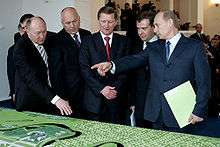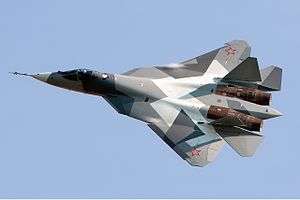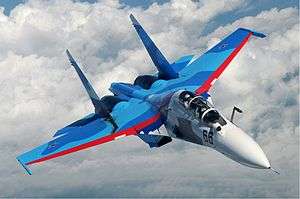Aircraft industry of Russia
Aircraft manufacturing is an important industrial sector in Russia, employing around 355,300 people. The dissolution of the Soviet Union led to a deep crisis for the industry, especially for the civilian aircraft segment. The situation started improving during the middle of the first decade of the 2000s due to growth in air transportation and increasing demand. A consolidation programme launched in 2005 led to the creation of the United Aircraft Corporation holding company, which includes most of the industry's key companies.
The Russian aircraft industry offers a portfolio of internationally competitive military aircraft such as MiG-29 and Su-27, while new projects such as the Sukhoi Superjet 100 are hoped to revive the fortunes of the civilian aircraft segment. In 2009, companies belonging to the United Aircraft Corporation delivered 95 new fixed-wing aircraft to its customers, including 15 civilian models. In addition, the industry produced over 141 helicopters.
History
First World War
Russia had twenty-four aircraft manufacturers at the outbreak of war, but they did not have the materials or the capacity to replace the aircraft that were lost. In particular they were dependent on foreign engines. It produced 1893 aircraft and imported 883 from 1914 to 1916, but it only produced 920 engines in this period while importing 2326. Production declined sharply after the February Revolution and had virtually ceased when Russia left the war in 1918. [1]
Soviet era
In the Soviet planned economic system, free market competition between companies was seen as wasteful, instead the Soviet system was a multi-tiered system the chief components of which were design bureaus, known as OKBs, and manufacturing complexes.
The OKBs did not possess the means to manufacture aircraft nor were they intended to, nor were the manufacturing complexes able to design aircraft or tied to individual OKBs instead they would produce whichever aircraft were assigned to them.
Operational requirements for proposed aircraft were created by the Soviet air forces to which individual OKBs would create a design informed by state research institutes, which would provide them with information on aerodynamics and available systems; because they were designed to similar requirements and research input, competing designs were very often very similar in appearance. These competing designs would then be evaluated against each other and a winner chosen. Ideally a single winning design would be chosen which would then be assigned to one or more manufacturing complexes. Most such complexes were within the Soviet Union, however some product lines were assigned to allies within the Warsaw Pact. Due in part to political considerations the assignment of production was widely dispersed, creating supply chains in which the role of state planning was paramount.
When exported a third tier existed in the state run export companies, neither design bureaus nor manufacturing companies were directly responsible for the marketing of their products overseas, nor did they directly benefit from the sale of their products, instead design and production units were allocated those resources deemed necessary to meet centrally determined production targets.
With the collapse of the Soviet Union, Warsaw Pact and Comecon there came a disconnect between end users, export companies, OKBs, assembly plants and component manufacturers (some of which now resided in newly independent and sometimes hostile nations). Russia also found that entire segments of its aviation requirements now lay in these foreign countries, for example the manufacture of jet training aircraft had been assigned to Czechoslovakia, while Poland got light helicopters and crop-dusting airplanes, Romania did also manufacture light helicopters, the majority of its tactical airlifter design capability in the form of the Antonov OKB was now in Ukraine, and the main assembly plant for the Sukhoi Su-25 ground attack aircraft was in Georgia.
Post-Soviet adjustments

Aerospace was a well-developed industry in the Soviet Union. In late 1980s, the Soviet Union accounted for 25% of the worldwide civilian and 40% of the worldwide military aircraft production.[3] The consequences of the Soviet Union's dissolution in 1991 were however catastrophic. The whole manufacturing sector was devastated by imports, while the aerospace and automobile industries barely managed to survive under highly protective tariffs.[4] On the positive side, the military aircraft industry managed to benefit from improving export possibilities. It profited from a large stock of components and parts which had been produced during Soviet times. The civilian aircraft industry fared much worse: while in 1990, the country had produced 715 civilian aircraft, by 1998 the number had dropped to 54 and in 2000 only 4 civilian aircraft were produced.[3]
As the industry structure was deeply fractionalised, the consensus was that consolidation was necessary. For this purpose, President Boris Yeltsin created the VPK-MAPO (Military Industrial Complex – Moscow Aircraft Production Association), which included some key companies such as Mikoyan. MAPO later became the Russian Aircraft Company (RAC) 'MiG'. This stage of consolidation was however not very successful, and MAPO was later merged with Sukhoi.[5]
The aerospace industry's total output in 2000 was $2.7 billion, with a net profit of $600 million. Exports of military aircraft in 2000 amounted to $1.3 billion.[3]
2000–2005: Start of a recovery

At the turn of the millennium, the civilian aircraft industry was in a deep crisis. Only a few aircraft were built and after-sale maintenance was minuscule. Many planes, both new and old, failed to receive international safety and environmental certifications. Two key companies, Aviastar-SP and Voronezh Aircraft Production Association were almost bankrupt. The profits of the civilian aircraft industry totaled just $300 million in 2001. In 2001–2006 the situation started improving considerably, as the industry started receiving new orders from leasing companies. Air transportation grew about 8% a year, and by 2004 domestic demand for new aircraft was soaring. Key companies managed to pay their debts or get them restructured, and production levels were increasing again.[6]
The military aircraft industry survived the 15 years of crisis almost exclusively through exports. Only in 2005 did the industry start to receive substantial financing from the state budget.[7]
2005–2010: Industry consolidation programme

In 2005, the government under President Vladimir Putin initiated an industry consolidation programme to bring the main aircraft producing companies under a single umbrella organization, the United Aircraft Corporation (UAC). The aim was optimize production lines and minimise losses. The programme was divided in three parts: reorganization and crisis management (2007–2010), evolution of existing projects (2010–2015) and further progress within the newly created structure (2015–2025).[8]
The UAC, one of the so-called national champions and comparable to EADS in Europe, enjoyed considerable financial support from the Russian government, and injected money to the companies it had acquired to improve their financial standing. The UACs first budget in 2007, was about 2 billion rubles, and next year it increased to 24 billion rubles (about $770 million).
The deliveries of civilian aircraft increased to 6 in 2005, and in 2009 the industry delivered 15 civilian aircraft, worth 12.5 billion roubles, mostly to domestic customers.[9]
Despite the global financial crisis, Russia's aircraft manufacturing industry as a whole managed to increase production and sales by 19.5% in 2009.[10]
New projects
Fifth-generation fighter

In 1998, the Russian Air Force asked the industry to develop a light multirole frontline aircraft. In 2001, the requirements were upgraded to a multirole frontline aircraft system, which later became the fifth-generation fighter PAK-FA, regarded as Russia's response to the American Joint Strike Fighter.[11] The PAK-FA performed its maiden flight in 2010, breaking America's complete monopoly on the development and production of fifth-generation jets. Moscow Defense Brief hailed it as a major coup for the Russian aerospace industry, saying that:
- "while not America’s equal militarily, Russia is still a solid second in terms of defense technology, outranking both Western Europe and China and punching well above its economic weight."
Russian prime minister Vladimir Putin has announced that government will increase financing of Russian defence industry complex.
Sukhoi Superjet 100

The Sukhoi Superjet 100 regional airliner is the first major Russian civilian aircraft whose development was started after 1991. The plane, which first flew in 2008, has been described as the most important and successful civil aircraft program of the Russian aerospace industry.[12] Designed by the United Aircraft Corporation subsidiary Sukhoi in cooperation with foreign partners, all versions of the plane are assembled by Komsomolsk-on-Amur Aircraft Production Association (KnAAPO) in the Russian Far East, while Novosibirsk Aircraft Production Association (NAPO) focuses on component production. The two companies have been heavily investing in upgrading of their facilities, and are expected to produce 70 airframes by 2012.[12]
Irkut MC-21
Development of the Irkut MC-21 passenger aircraft was begun in the early 2000s. The aircraft, which has a passenger capacity of 150–200 and a range of 5,000 km, is being designed by Irkut Corporation in cooperation with foreign partners. It is targeted at the most popular segment of the domestic airline industry, and is intended to replace older planes such as the Tupolev Tu-154. The program is currently in the production phase. The MC-21 certification and delivery was initially planned by 2016,[13] but delivery was delayed to 2017. The developers aim to sell 1,200–1,500 planes in total, amounting to a 12–15% share of the international market.[14]
Other projects
Other new aircraft developed in recent times include the Yak-130 advanced trainer and light attack jet, the modernized Tu-204SM and the Ukrainian An-148 regional aircraft, which is mostly manufactured in Russia in Voronezh. Russian manufacturer of amphibian aircraft Beriev also aim to manufacture several new designs for passenger traffic.
Structure

In 2008, the aircraft industry consisted of 106 enterprises, 18 of which belonged to the United Aircraft Corporation.[15] One of the most successful companies is Sukhoi,[16] which possesses a wide portfolio of internationally competitive military aircraft, including the Su-27, Su-30 and Su-35 models. On the civilian segment, the company's most important project is the Superjet 100.[5] Komsomolsk-on-Amur Aircraft Production Association, Russia's largest aircraft enterprise, is responsible for manufacturing Sukhoi products.[17] Joint Stock Company Tupolev focuses on the civil aviation market with its Tu-204 and Tu-214 planes, but is also responsible for the long-range bomber Tu-160 and for developing its successors. Mass production of Tu-204 planes is accomplished by Aviastar SP, located in Ulyanovsk, while the Tu-214 variant is produced by Kazan Aircraft Production Association.[17] Ilyushin focuses on the military cargo and transport sector. Irkut has a portfolio of trainer and amphibious aircraft projects and competes in the onboard electronics and avionics niche.[5] In the unmanned aerial vehicle segment, ZALA Aero and Vega Radio Engineering Corporation are among the leading companies.
| United Aircraft Corporation | Russian Helicopters JSC | Other major producers: | |
|
Aviakor |
Scientific institutions
- Central Aero-Hydrodynamic Institute (TsAGI) .Founded in 1918, located in Zhukovsky.
The main activities:
- theoretical, experimental and applied research in the field of aerodynamics and flight dynamics, control systems, strength and aeroelasticity aerothermodynamics and gas dynamics, advanced aircraft, unique experimental equipment [6], hydrodynamics and aeroacoustics, including developments in nanotechnology
- aircraft certification
- conclusion on the strength and aerodynamics
- design of wind tunnels and stands
- development of numerical methods and software
- foreign economic activity
- execution of orders and contracts with foreign customers
At the disposal of the Institute - more than 60 wind tunnels and test stands for testing of strength, acoustics, and dynamics aerohydrodynamics aircraft.
- Gromov Flight Research Institute (LII) .Founded in 1941, located in Zhukovsky. Test airfield (Zhukovsky) and Research Center .Every two years at the airport hosts the International Aviation and Space Salon (MAKS)
- Baranov Central Institute of Aviation Motor Development (TsIAM) .Founded in 1930, located in Moscow.
- All-Russian Research Institute of Aviation Materials (VIAM) .Founded in 1932, is located in Moscow.
- State Research Institute of Aviation Systems (GosNIIAS) .Founded in 1946, located in Moscow.
Production

Civilian aircraft production
| Type | 2005 | 2006 | 2007 | 2008 | 2009 | 2010 | 2011 | 2012 | 2013 |
|---|---|---|---|---|---|---|---|---|---|
| An-140 | 1 | 1 | 1 | 1 | 2 | 3 | |||
| An-148 | 2 | 5 | 5 | 3 | 6 | ||||
| An-38 | 1 | ||||||||
| Il-96 family | 1 | 2 | 2 | 2 | 2 | 1 | 1 | 1 | |
| Tu-154M | 1 | 1 | 1 | 1 | 2 | ||||
| Tu-204 family | 3 | 3 | 3 | 6 | 4 | 1 | 3 | 2 | |
| Tu-214 | 1 | 2 | 1 | 2 | 2 | 3 | 1 | 2 | |
| Be-200 | 1 | 1 | |||||||
| SSJ-100 | 1 | 2 | 5 | 12 | 24 | ||||
| Il-76 family | |||||||||
| Total | 6 | 9 | 8 | 9 | 12 | 12 | 19 | 24 | 36 |
| Sources:[18][19][20] | |||||||||
Military aircraft
On the military segment, companies belonging to UAC delivered 84 new aircraft and knockdown kits. Over 60 aircraft were modernized or underwent overhaul.[22]
Helicopters
| Type | 2012 | ||||||
|---|---|---|---|---|---|---|---|
| Mi-8 family | 193 | ||||||
| Mi-35 family | 29 | ||||||
| Mi-26 | 7 | ||||||
| Mi-28N | 18 | ||||||
| Ka-31 | 1 | ||||||
| Ka-32А11ВС | 5 | ||||||
| Ka-52 | 21 | ||||||
| Ka-226 | 11 | ||||||
| Ansat | 5 | ||||||
| Total | 290 | ||||||
| Sources:[23] | |||||||
Revenue
The aircraft industry's revenue from sales in 2008 was 226.6 billion rubles (105.3 billion for UAC), and the export share was 29% (52.5% for UAC).[24]
Economic significance
Russia's aircraft industry is one of the backbone branches of the country's economy. It is one of the most science-intensive hi-tech sectors and employs the largest number of skilled personnel. The production and value of the military aircraft branch far outstrips other defense industry sectors, and aircraft products make up more than half of the country's arms exports.[25]
Employment
In 2008, the number of personnel estimated to be working for the aircraft industry was 355,300.[15] The United Aircraft Corporation holding, which encompasses most of the industry's key companies, had 97,500 employees in 2009. Of this amount, 85,500 worked in production at factories, 11,100 worked in the design bureaus and 900 in management and leasing companies. The average age of UAC personnel working in production was 44 years, and 49 for the personnel working in the design bureaus. The ratio of higher education graduates was 34%.[15]
See also
References
- ↑ Tucker, Spencer (2005). World War I A-D Volume 1. ABC-CLIO,. ISBN 1851094202.
- ↑ Ruslan, Pukhov (2001). "MiG Design and Production System: Post-Soviet Transformations". Eksport Vooruzheniy (2).
- 1 2 3 Kwiatkowski, Alex (2003-02-07). "BUSINESS. Aviation industry locked in a tailspin". The Russia Journal.
- ↑ Rutland, Peter (2005). "Putin's Economic Record". In White; Gitelman; Sakwa. Developments in Russian Politics. 6. Duke University Press. ISBN 0-8223-3522-0.
- 1 2 3 "Russia Reconsolidates Military Aerospace Arena". Net Resources International.
- ↑ Makienko, Konstantin (2007). "The Russian Aviation Industry: From European Option to National Strategy". Moscow Defense Brief. Centre for Analysis of Strategies and Technologies (2).
- ↑ Makienko, Konstantin (2005). "Evolution of Russia's Defense Industry in 2005". Moscow Defense Brief. Centre for Analysis of Strategies and Technologies (1).
- ↑ Zvereva, Polina (2009-10-11). "State-sponsored consolidation". Russia & CIS Observer. 3 (26).
- ↑ "Annual Report 2009" (PDF). United Aircraft Corporation. 2010.
- ↑ UAC Annual Report 2009, p. 19
- ↑ Sokut, Sergey (2001). "Russia Seeks Quick Response to JSF". Eksport Vooruzheniy. Centre for Analysis of Strategies and Technologies.
- 1 2 Pyadushkin, Maxim. "Celebrating the 100th anniversaryThe Sukhoi Superjet 100 makes its debut at Le Bourget". Russia & CIS Observer. 2 (25).
- ↑ Семейство ближне-среднемагистральных пассажирских самолётов МС-21 [MS-21] (in Russian). United Aircraft Corporation. Retrieved 18 December 2008.
- ↑ Sinitsky, Alex (2009-11-01). "Drawing the contours". Russia & CIS Observer.
- 1 2 3 UAC Annual Report 2009, p.45
- ↑ Makienko, Konstantin (2008-07-24). "Successful Year for Aerospace Manufacturers". Russia & CIS Observer. Retrieved 2010-01-06.
- 1 2 UAC Annual Report 2009, p.96
- ↑ Pyadushkin, Maxim (2010-02-15). "Facing Low Demand. Russian Aircraft Manufacturers Increased Deliveries in 2009, But This Year's Sales Remain Uncertain". Russia & CIS Observer.
- ↑ "UAC announces preliminary results for 2010". United Aircraft Corporation. 2011-02-01.
- ↑ http://sdelanounas.ru/blogs/25482/
- ↑ http://aeropress-bg.com/novini/36-news/1891-ruskata-industria-e-postroila-36-patnicheski-samoleta-za-2013.html
- ↑ UAC Annual Report 2009, p.4
- ↑ http://bmpd.livejournal.com/491764.html
- ↑ UAC Annual Report 2008, p.16
- ↑ Manturov, Denis (2009). "Prospects for the Domestic Aircraft Industry". Military Parade (4): 8–9.



